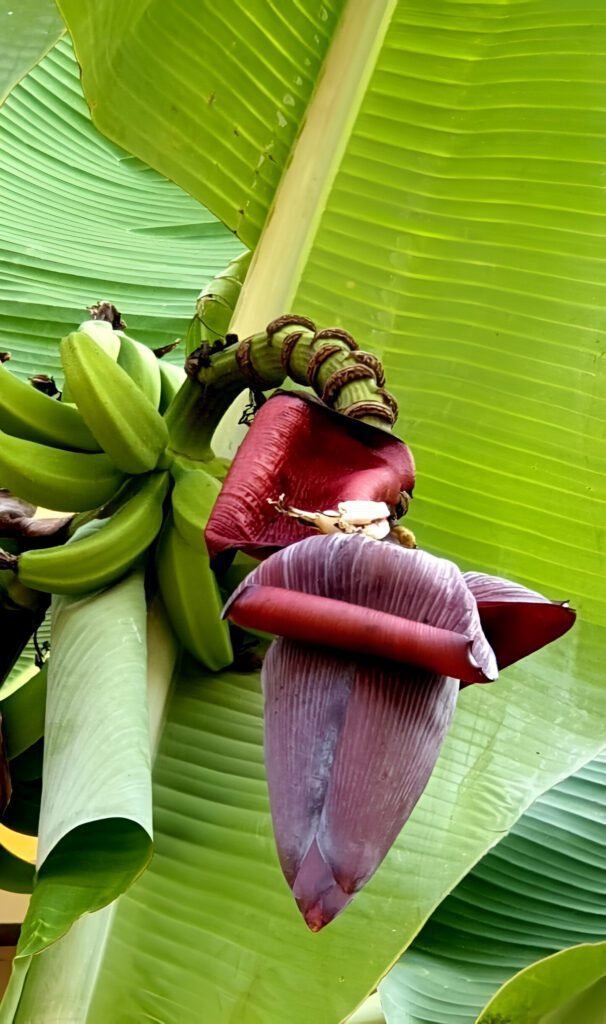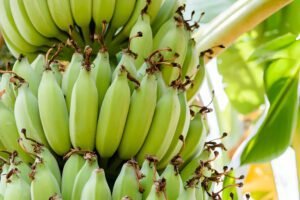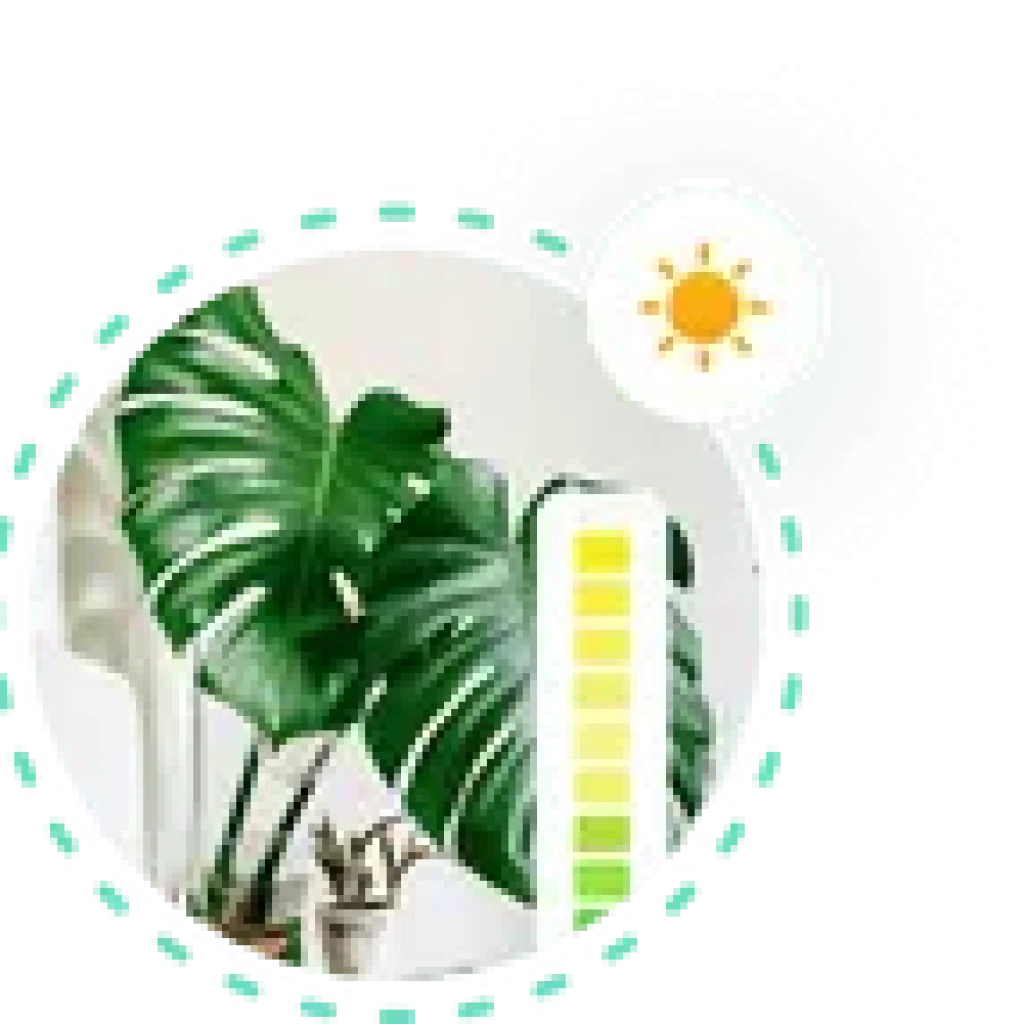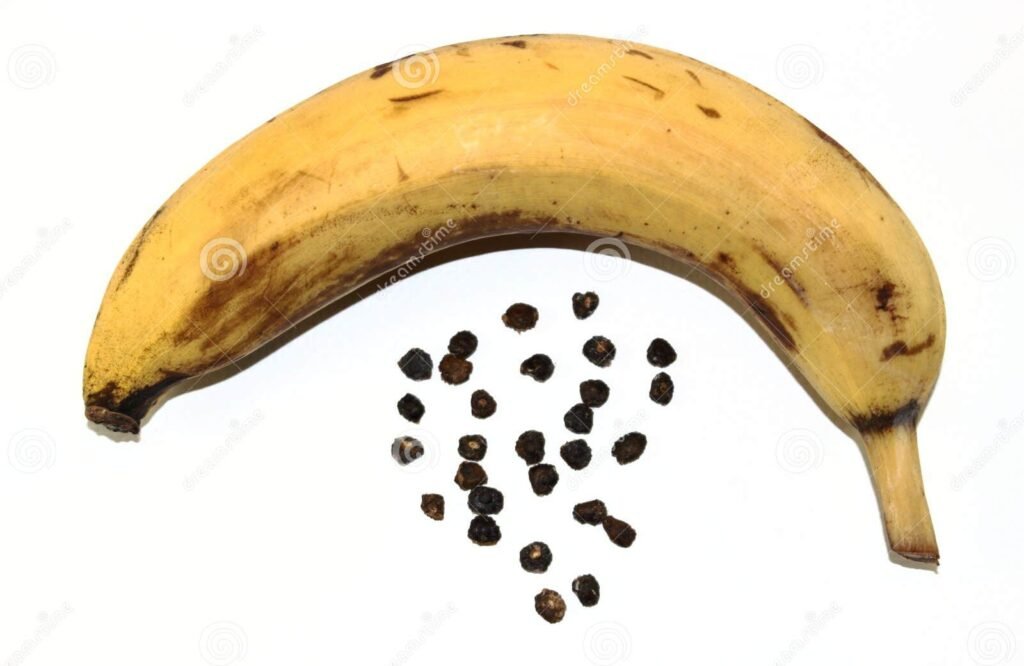Banana: definition, how to grow it, diseases, care for it
Introduction to bananas
A massive herb that stems from an underground stem, or rhizome, to form a false stem. The leaves are oblong to elliptical, sometimes up to 3-3.5 m (10-11.5 ft) long and 65 cm (26 in) wide. The flowers are yellow protected by large purple-red bracts, in the lower part. The upper part of the false stem curves downward into clusters of 50 to 150 individual fruits or fingers. The fruits are collected in clusters.
- Beneficial for heart health, weight control, and increasing immunity
- Banana flowers are a rich source of iron. It also contains fibers that help improve the digestive system in the human body

Basic care guide
The most important types:
Musa acuminata: This species reaches about 12 to 20 feet tall and is often grown for its ornamental foliage thanks to its paddle-shaped leaves that can reach about 6 to 10 inches long.
Musa ornata: Commonly referred to as the flowering banana tree, this species is mostly grown for its ornamental value; Its small fruits are not usually eaten.
Musa acuminata: This species reaches about 12 to 20 feet tall and is often grown for its ornamental foliage thanks to its paddle-shaped leaves that can reach about 6 to 10 inches long.
- Original home
India and Southeast Asia
- Nickname
There is a nickname given to the banana tree, which is its father's killer. The reason for this name is that after collecting banana fruits. The tree is cut down so that others can emerge and grow.
- Platoon : Musaceae
- Suitable living conditions
Humid tropical climates, grows successfully in semi-arid areas
- Temperatures
It prefers consistent temperatures between 75 and 95 degrees Fahrenheit. Cold temperatures and dry conditions can quickly kill plants
- Suitable lighting for him
A sunny area is best for the banana tree. The tree needs at least 7 to 8 hours of direct sunlight.
- The amount of water needed
- Banana trees are tropical plants that grow naturally in rainforests, and require abundant water and a humid environment.
- For optimal growth, it is recommended to plant them in groups because this helps retain moisture in the leaves.
- Regular watering is necessary to keep the soil constantly moist, but be careful not to overwater as it may lead to root rot. It is important to strike a balance to provide adequate hydration without over-saturating the soil.

Suggested use
- The fruit is edible.
- You can use stem fibers as natural craft materials.
- You can use banana plant fibers to make clothes.
- Banana peels are suitable for animals such as cows and goats
Fruiting stage
It takes about 9 months for banana trees to grow to their full height, and only 12 months for them to bear their first fruit.
Flowering stage
in spring
- Plant age
25 years
- Plant height
From 2 to 30 feet
- These plants like deep, organically rich soil with good drainage and a slightly acidic soil pH.
- These plants like deep, organically rich soil with good drainage and a slightly acidic soil pH.
- You can add some perlite to keep it draining well.
- To adjust soil salinity:
Plow the land with a two-plow plow for deep plowing. – Irrigate the land more than once with low-salt water and try to drain it superficially. Adding agricultural gypsum (calcium sulphate) to the land, 750 kg/ha, and stirring it by plowing into the soil. - Irrigating the land abundantly and leaving the ground to absorb the water inside it without draining it superficially, while irrigating the land more than once until the salts are exchanged.


Find out what light your plants are actually getting.
Find the best locations for them to improve their health, simply using your phone.
How to plant seeds
- If you've ever sliced a banana from the grocery store, you may see little black dots that look like seeds. These “banana seeds” are immature and sterile and cannot be planted and grown
- If you have the opportunity to venture into the wild and open a naturally grown wild banana, you will likely find the seeds inside. Some varieties have very large seeds
- الطريقة :
- Place the seeds in a bowl, then cover them with warm water, changing the water when it cools.
- Leave the seeds soaked for 48 hours to help the embryo grow.
- Place the seeds in the seed tray inside. Use a potting soil that contains plenty of compost and more than half of which is sandy/aerated loam.
- Seeds can germinate in two to three weeks or it can happen in two or more months or more.
- Water the tray until the soil is moist but not soggy. Be careful not to drown the seeds.
- Seeds can germinate in two to three weeks or it can happen in two or more months or more.
Fertilization care
- Young plants need one-quarter to one-half pound of fertilizer per month. A balanced 8-10-8 (NPK) fertilizer is recommended.
- During warm weather, apply once a month.
- Distribute the fertilizer evenly around the plant in a circle around the trunk.
- Do not allow fertilizer to come into contact with the trunk.
Pruning
- Before fruiting, it is recommended to prune the banana tree, leaving only one main stem.
- After approximately six to eight months of growth, keep a single sucker (a small bud at the base of the stem) to replace the main stem the following growing season.
- Once the fruit is harvested, cut the main stem back to a height of 2.5 feet.
- Over the next few weeks, gradually remove the remaining stem, making sure the replacement sucker remains intact. This pruning technique helps keep the banana tree growing and productive
- Banana Xanthomonas wilt (BXW) is a bacterial infection. The affected plant appears pale yellow-orange and in the later stage becomes dark brown. Ultimately, it leads to death, and this may lead to 100% crop loss if it is not managed well. The treatment for this disease is by disinfecting the field and removing the infected plant parts, or spraying streptocycline 200 ppm after the first visual symptoms appear, every 10 days.
- Fusarium wilt : This is a fatal fungal infection that originates from the soil-borne fungus Fusarium oxysporum. The first sign of the disease is wilting, which produces a yellow color in the old leaf... The proposed treatments for this disease are to place 2.5 kg/ha of Pseudomonas Fluorescent bacteria on the farm along with natural fertilizer.
- Banshee top virus : It is a viral infection caused by a single-stranded DNA virus.. The symptoms of this infection usually occur in older plants in which the last leaves are yellow and narrower than usual. The common treatment for this disease is an injection of 4 ml of fernoxone solution with 400 ml of water or an injection of 4 ml of monocrotophos at a ratio of 1:4, at an interval of 45 days until flowering in the third month. Also, by spraying 1 ml of phosphamidone, 2 ml of methyldimeton, or 1 ml of monocrotophos with water, the spread of the disease can be avoided.




